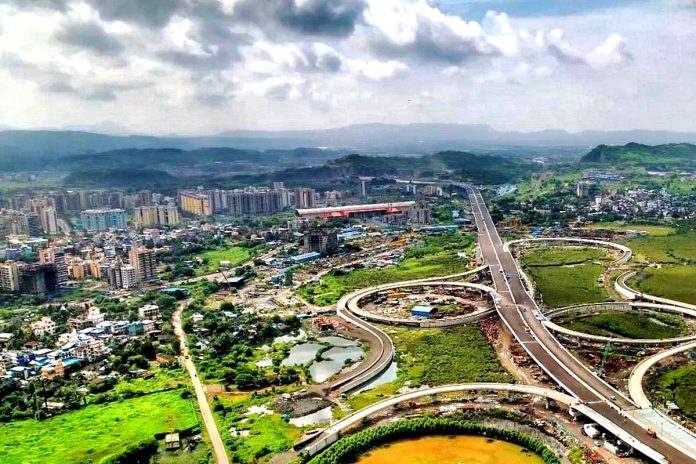The Mumbai Trans Harbour Link project embodies the epitome of modern technology, designed for a lifespan of 100 years and constructed using state-of-the-art Japanese technology.
Remarkably, the bridge features Orthotropic Steel Deck spans ranging from 65 metres to 180 metres, a first-of-its-kind achievement in India.
The Mumbai Trans-Harbour Link (MTHL), India’s longest sea bridge, is approaching its final stages of construction, with an impressive 96.60 per cent of the project completed.
Dr Sanjay Mukherjee, IAS, and commissioner of the Mumbai Metropolitan Region Development Authority (MMRDA), recently conducted a comprehensive inspection of this colossal undertaking.
During the inspection, Dr Mukherjee convened meetings with stakeholders and diligently assessed the project’s progress. He expressed his contentment with the ambitious project’s advancement, highlighting the MTHL’s pivotal role in regional development.
The MMRDA remains committed to completing the project within the stipulated timeline, envisioning its seamless integration into Mumbai and Navi Mumbai’s transportation network.
Dr Mukherjee projected that these projects could boost the state GDP by five per cent and increase the national GDP by one per cent, earning the MTHL its reputation as a game changer as per the Times Of India report.
Mukherjee further stated that the MTHL’s significance lies in its ability to bring Mumbai and Navi Mumbai closer together, connecting Shivri in Mumbai to Uluwe and Chirude in Navi Mumbai.
According to Dr Mukherjee, the Mumbai Trans-Harbour Link project embodies the epitome of modern technology, designed for a lifespan of 100 years and constructed using state-of-the-art Japanese technology.
Work on the project, a 22-km-long sea link connecting Mumbai with its satellite city Navi Mumbai, got off to a start in April 2018 with the contractor conducting soil testing in the Nhava Sheva Creek.
India’s Longest Sea Bridge
The MTHL will cover about 22 km, including 16.5 km over the sea and 5.5 km on land.
This engineering marvel connects Mumbai to Navi Mumbai, providing commuters with a seamless and swift 20-minute journey between these two key locations, free from traffic signals.
Furthermore, the MTHL promises to enhance connectivity to essential transportation arteries like the Mumbai-Goa highway, Mumbai-Pune expressway, Navi Mumbai International Airport, and the JNPT port.
Additionally, the project will promote greater economic integration of Mumbai, Navi Mumbai, and their extended regions such as Pune, Goa, Panvel, and Alibaug.
Remarkably, the bridge features Orthotropic Steel Deck spans ranging from 65 metres to 180 metres, a first-of-its-kind achievement in India, according to the MMRDA.
Noteworthy aspects of the MTHL include an automated toll collection system and an intelligent transport system.
Another significant feature is the resilience of the lighting poles installed on the bridge, designed to withstand the harsh challenges posed by the deep sea environment.
A total of 1,212 lighting poles will be installed, with 20 per cent of them already in place. These poles are equipped with a central control and monitoring system, ensuring their suitability for the saline environment.
Mumbai Trans harbour link (Droneman)Mumbai Trans harbour link
Sewri interchange with eastern freeway (MMRDA)
They are coated with a corrosion-free polyurethane coating, feature galvanisation to prevent rust and prolong their lifespan, and possess a structural design capable of withstanding high wind velocities.
Additionally, the lighting poles are equipped with a lightning protection system to guard against potential damage from lightning strikes.
The MTHL has interchanges at Sewri in Central Mumbai, Shivaji Nagar at Mumbai Bay and NH-4 B at Chirle, Navi Mumbai.
(Droneman)Chirle Interchange (Droneman)
Four Packages
The MTHL bridge has been split into four packages — while packages 1 and 2 are sea-based, package 3 is on land.
Package-1 spans from Sewri (0.00 km) to 10.380 km and Package-2 is from Sewri (10.380 km) to 18.189 km. Package 3 covers the stretch of the bridge from Sewri (18.187 km) and continues for 3.60 km, concluding on land at 21.80 km.
Mumbai Trans Harbour Link (MMRDA)
Lastly, Package 4 entails work related to the installation of an intelligent transport system, toll management system, electrical works, highway illumination system, and construction of toll plazas and administrative buildings including the command control centre.
Financing
Then Devendra Fadnavis government’s war room revived the project in 2015. Two crucial state and central clearances were obtained between November 2015 and January 2016.
In February 2016, funding from Japan International Cooperation Agency (JICA) was secured subject to design changes and construction standards. The central government readily stood as a counter guarantee for the JICA loan.
The project, with an estimated cost of nearly Rs 18,000 crore, has received significant funding from the JICA.
JICA extended an official development assistance loan of 30,755 million Japanese Yen (approximately Rs 1,927 crore) for the MTHL project in Maharashtra.
This loan agreement is the third tranche of JICA financing for MTHL, and the loan agreements for the first and second tranches were signed on 31 March 2017 and on 27 March 2020, respectively.


